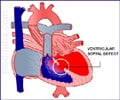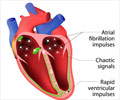Researchers revealed that the treatment rates for atrial fibrillation continue to be low in spite of the FDA approving a novel blood thinner known as dabigatran.

"Dabigatran has been briskly adopted into clinical practice since its October 2010 Food and Drug Administration approval for the prevention of stroke among patients with non-valvular atrial fibrillation," said G. Caleb Alexander, MD, MS, lead author of the study and a research scientist in the Bloomberg School's Department of Epidemiology. "Between 2007 and 2011, use of the oral anticoagulant warfarin declined from approximately 2.1 million quarterly physician visits to approximately 1.6 million visits while since its release, dabigatran use increased from 3.1 percent to 18.9 percent of physician visits where an oral anticoagulant was used."
Using data from the IMS National Disease and Therapeutic Index, a nationally representative audit of ambulatory providers, Alexander and colleagues quantified patterns of oral anticoagulant use among subjects between 2007 and 2011. Focusing on the oral anticoagulant drugs, dabigatran and warfarin, they examined treatment patterns by patient age, provider specialty and common indications for oral anticoagulation. Pharmacy expenditures for warfarin and dabigatran were quantified using a nationally representative audit of retail, mail order and long-term care pharmacies.
According to the National Institutes of Health, atrial fibrillation is the most common type of arrhythmia and, compared with their counterparts, patients with atrial fibrillation have an increased risk of stroke. Previous research has indicated the use of oral anticoagulants may reduce the risk of thromboembolic events like stroke by up to two-thirds and is especially vital in the prevention of such events among high-risk individuals.
The authors conclude that, "a better understanding of how these therapies are being applied in the real world is an important step in understanding their potential to ultimately improve care."
Advertisement











